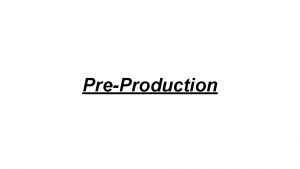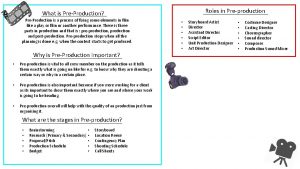Christmas Charity Appeal PreProduction Jasmin Perry My Ideas









- Slides: 9

Christmas Charity Appeal: Pre-Production Jasmin Perry

My Ideas, Impact and Audience Unit 1 – LO 1. 1 Unit 3 – LO 2. 2 • The idea for my advert is a print advert, A 1 size for a Christmas charity appeal; my advert is about Depression. The charity I am focusing this project on is Child. Line. • The impact I want to make is to make people realise how depression can effect anyone and how at Christmas the people affected by depression can be overlooked. • My audience is focussed on the Child. Line ages which is for children and young people up to their 19 th birthday in the UK

Research methods and why and About Child. Line • I’ll use the Child. Line website, various mental health websites and Wikipedia to research the charity because they’ll have the most information. I will use this information to get ideas of how to place my appeal together. • “Child. Line is a private and confidential service for children and young people up to the age of 19. You can contact a Child. Line counsellor about anything -no problem is too big or too small. ” http: //www. childline. org. uk/pages/about. aspx (visited 2 nd December 2015) • Child. Line deals with any issue which causes distress or concern, common issues dealt with include child abuse, bullying, mental illness, parental separation or divorce, pregnancy and substance misuse. • In 1986 Esther Rantzen, presenter of ‘That's Life!’, a popular consumer TV show, suggested to the BBC that they create "Childwatch", a programme about child abuse, the aim being to try to detect children at risk before their lives were in danger. • A helpline was opened after the programme so that any child currently suffering abuse could call for help. Rantzen, together with her BBC producers Sarah Caplin and Ritchie Cogan, therefore suggested they should create a helpline specifically for children in danger or distress, to be open throughout the year, 24/7, and launch it on the programme. The project was made possible by a benefactor Ian Skipper who underwrote the charity for the first three years. • Child. Line joined the NSPCC in February 2006, and extra resources were pledged in an attempt to ensure that no child's call goes unanswered. https: //en. wikipedia. org/wiki/Child. Line (visited 2 nd December 2015) Unit 2 – LO 3. 1, 3. 2

About Depression Unit 2 – LO 3. 1, 3. 2 • Depression is a common mental disorder that causes people to experience depressed mood, loss of interest or pleasure, feelings of guilt or low self-worth, disturbed sleep or appetite, low energy, and poor concentration. • Depression is different from feeling down or sad. Unhappiness is something which everyone feels at one time or another, usually due to a particular cause. A person suffering from depression will experience intense emotions of anxiety, hopelessness, negativity and helplessness, and the feelings stay with them instead of going away. • Depression can happen to anyone. Many successful and famous people who seem to have everything going for them battle with this problem. Depression also affects people of every age. • http: //www. mentalhealth. org. uk/help-information/mental-health-az/D/depression/ • (vistited 7 th December)

Other adverts Emotional persuasion • Emotional persuasion is used to make people feel emotionally attached to an object or person so they feel obliged to give money or raise awareness. • Child. Line use images of things that children can relate to so that it can be easy for children to get in contact or to understand. Unit 4 – LO 1. 1, 1. 2, 1. 3

Mood Board • These pictures I have placed here are the ideas I want to use for my appeal because they cover some of the aspects of Depression and Christmas put together. Unit 4 – LO 1. 3, 2. 2

Sketches of ideas – Photoshop practice I used photoshop to do my sketches because the ideas I wanted wouldn’t work on Paper. The idea I had in my mind was a family having fun and a child in the background looking depressed and sad but with a happy face covering it slightly, showing that behind a mask is the real feelings and that at Christmas the thing that matters most is family having fun and that if someone is… Unit 1 – LO 1. 1 Unit 3 – LO 2. 2 …. Suffering then you need to notice, look deeper as such and help them to make the most of Christmas.

ASA Codes for Limitations and Restrictions • • Unit 3 – LO 2. 2 6. What types of advertising are within the ASA’s remit? The ASA broadly regulates advertising that appears on TV, radio, cinemas, billboards, print media and online. A full list of the type of ads that the ASA regulates can be found here. The Copy Advice team advises only on non-broadcast media. That includes, for example, magazines, newspapers, leaflets and brochures but also online media, including claims on advertisers’ own websites. 7. What are the main requirements of the CAP Code? The Code lays down rules for advertisers, agencies and media owners to follow. They include general rules that state advertising must be responsible, must not mislead, harm or offend, and specific rules that cover, for example, advertising to children and ads for alcohol, gambling, motoring, health and financial products. The Code is applied in the spirit and the letter. Advertising should be prepared with a sense of responsibility to consumers and to society. Advertisers should hold documentary evidence to prove claims that consumers are likely to regard as objective and are capable of substantiation. In short, advertisers should not make claims if they cannot prove them to be true. Advertising Regulation Q&A 4 8. What does the Copy Advice team do? The Copy Advice team offers advice designed to help marketers create non-broadcast marketing communications or multi-media concepts that comply with the CAP Code. The team provides a wide range of advice and guidance on its website, for example the Advice Online database. The team also provides a fast and confidential bespoke advice service. The service is free for a 24 -hour turnaround or, if you need the advice urgently, it can be provided in under half a day, for a fee. You can also ask for a website audit, where we will review the advertising claims on your own website, again for a fee. We base our advice on ASA adjudications, our knowledge of the Code and our experience of judging how we think the ASA would rule if it were to receive a complaint. 9. Who is in the Copy Advice team? Our advisors are experts in understanding the CAP Code and how the ASA has interpreted the Code in the past. Offering a range of experience and expertise, they keep abreast of complaints made to the ASA as well as all ASA adjudications, whether or not the ASA Council upheld the complaint. You can find out who the team are here. 10. Do I have to take your advice? No, you are not obliged to act upon the advice we give but no one can give you more informed advice about your claim’s acceptability under the CAP Code. 11. What happens if I don’t? If the ASA receives complaints about your ad and investigates, it will know if you sought advice from Copy Advice and chose not to act upon our recommendations. Conversely, if the ASA investigates complaints about a campaign that has benefited from Copy Advice, it will take this into consideration, often to positive effect. 12. What are the ASA’s sanctions? If the ASA upholds a complaint against an advertisement, then the ad must be amended or withdrawn. The self-regulatory system generally, and the Copy Advice team specifically, aims to ensure advertising standards and compliance rates are high. It favours co-operation over coercion and would rather educate than punish. Of course, the ASA has a number of sanctions for those advertisers who are unwilling or unable to comply with its rulings, including the withdrawal of media space, the removal of trading privileges, compulsory pre-vetting and referral to the Office of Fair trading for possible statutory sanctions. • https: //www. cap. org. uk/News/~/media/Files/Copy%20 Advice/Advertising%20 Regulation%20 QA%20 September%20(Sept%202011). ashx • (visited 9/12/2015)

CANTERBURY COLLEGE MEDIA DEPARTMENT Unit 1 – LO 1. 2 RISK ASSESSMENT SHEET 1. For the activity, identify and list the possible hazards. 2. Then rate the level of risk – 1 being the least risk and 9 the greatest. 3. List the actions you will take to control and reduce the risks identified. Activity Hazards Actions/Controls Level of Risk Photographing a picture of a teenager, in various different poses (in this case the teenage model is me) Tripod causing a trip hazard, uneven surfaced floor, over heating of electrical equipment leading to the cause of a fire, overhead light covers falling, Check all equipment before using; including wires and batteries ect. LOW risk - 3 Signed: JPerry Print Name: JASMIN PERRY Date: 10/12/2015

















